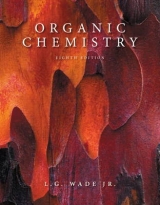
Organic Chemistry
Pearson (Verlag)
978-0-321-59231-6 (ISBN)
- Titel erscheint in neuer Auflage
- Artikel merken
Organized around functional groups, Wade’s text is known for its student-oriented approach—incorporating problem solving help, orientation features, and complete discussions of mechanisms. Wade explains concepts without taking the unnecessary short cuts that often lead to misconceptions.
Wade’s hallmark problem-solving approach includes unique strategies and hints to help students focus on the individual steps of each reaction and how they contribute to the overall reaction. Wade also employs the most pedagogically efficient method of mechanism boxes with its two-tiered approach: Mechanism and Key Mechanism Boxes. Because there are over 100 mechanisms boxed in every text, Wade delineates the 20 “Key” mechanisms that comprise nearly all of the mechanisms students will encounter. This means Wade goes one additional and important step in helping students identify and grapple with the smallest number of the most important concepts to understand.
L.G. “Skip” Wade decided to become a chemistry major during his sophomore year at Rice University, while taking organic chemistry from Professor Ronald M. Magid. After receiving his B.A. from Rice in 1969, Wade went on to Harvard University, where he did research with Professor James D. White. While at Harvard, he served as the Head Teaching Fellow for the organic laboratories and was strongly influenced by the teaching methods of two master educators, Professors Leonard K. Nash and Frank H. Westheimer. After completing his Ph.D. at Harvard in 1974, Dr. Wade joined the chemistry faculty at Colorado State University. Over the course of fifteen years at Colorado State, Dr. Wade taught organic chemistry to thousands of students working toward careers in all areas of biology, chemistry, human medicine, veterinary medicine, and environmental studies. He also authored research papers in organic synthesis and in chemical education, as well as eleven books reviewing current research in organic synthesis. Since 1989, Dr. Wade has been a chemistry professor at Whitman College, where he teaches organic chemistry and pursues interests in organic synthesis and forensic chemistry. Dr. Wade received the A.E. Lange Award for Distinguished Science Teaching at Whitman in 1993. Dr. Wade’s interest in forensic science has led him to testify as an expert witness in court cases involving drugs and firearms, and he has worked as a police firearms instructor, drug consultant, and boating safety officer. He also enjoys repairing and restoring old violins and bows, which he has done professionally for many years.
1 Introduction and Review
2 Structure and Properties of Organic Molecules
3 Structure and Stereochemistry of Alkanes
4 The Study of Chemical Reactions
5 Stereochemistry
6 Alkyl Halides: Nucleophilic Substitution and Elimination
7 Structure and Synthesis of Alkenes
8 Reactions of Alkenes
9 Alkynes
10 Structure and Synthesis of Alcohols
11 Reactions of Alcohols
12 Infrared Spectroscopy and Mass Spectrometry
13 Nuclear Magnetic Resonance Spectroscopy
14 Ethers, Epoxides, and Sulfides
15 Conjugated Systems, Orbital Symmetry, and Ultraviolet Spectroscopy
16 Aromatic Compounds
17 Reactions of Aromatic Compounds
18 Ketones and Aldehydes
19 Amines
20 Carboxylic Acids
21 Carboxylic Acid Derivatives
22 Condensations and Alpha Substitutions of Carbonyl Compounds
23 Carbohydrates and Nucleic Acids
24 Amino Acids, Peptides, and Proteins
25 Lipids
26 Synthetic Polymers
Appendices
Answers to Selected Problems
Photo Credits
Index
| Erscheint lt. Verlag | 19.2.2009 |
|---|---|
| Sprache | englisch |
| Maße | 216 x 267 mm |
| Gewicht | 2720 g |
| Themenwelt | Naturwissenschaften ► Chemie ► Organische Chemie |
| ISBN-10 | 0-321-59231-X / 032159231X |
| ISBN-13 | 978-0-321-59231-6 / 9780321592316 |
| Zustand | Neuware |
| Informationen gemäß Produktsicherheitsverordnung (GPSR) | |
| Haben Sie eine Frage zum Produkt? |
aus dem Bereich



